
BILL'S
[Somewhat] WEEKLY COLUMN/BLOG PAGE

For God's Sake, Fella PAY To Get In !
Many decades ago, an old racing veteran was relating in an interview what about the surprises and unexpected situations that would arise while screaming around one of those dangerous, highly – banked board tracks that were all the rage for a short [thank goodness] while early in the 1900's. What I recall most from that what that man had to say was mentioning [in explaining how those tracks often needed some maintenance] that he clearly remembered seeing a small boy poke his head up, through a hole in he boards, as the driver flew past.
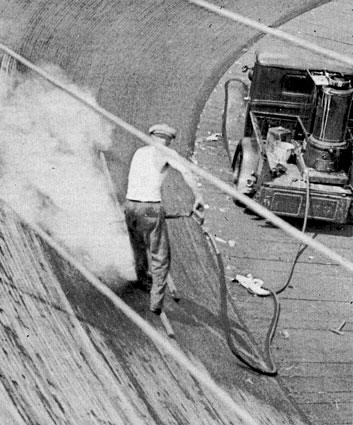
From LIFE Magazine
A worker steam cleans part of the huge Nutley
Velodrome in the 1930's.
Probably maintenance was not exactly excessive on most of them.
Perhaps not as dangerously as that kid, people have been trying to get a free look at racing for a really long time. Although race venues soon learned that one guy standing at the access road with a nail apron, taking admission was not going to be enough to control the ingress of people to a race, people have found more creative ways to mange to view races without paying; and, sometimes that made for dangerous situations. Stock car racing history is peppered with stories like NY's Palmyra Speedway, which had to fold because it couldn't control the flow of freeloaders into the track property.
One of the earlier tracks in this particular written piece was Pico Raceway, Rutland Vermont. Except for one race held in 1954, Pico basically only staged races in 1951 and 1952. Although the track was an increasing nice facility which was attracting major teams from a number of areas and states, the triumvirate of owners did not pay their bills and it drowned in a sea of red ink.
Aldo Merusi Photo via John Nelson
Pico started out with spectators already
protected by a sand bank.
Below – They went the extra distance in 1952 to construct a
cement wall and corresponding bleacher front improvements.
This shot shows Proctor's Tony Provencher.
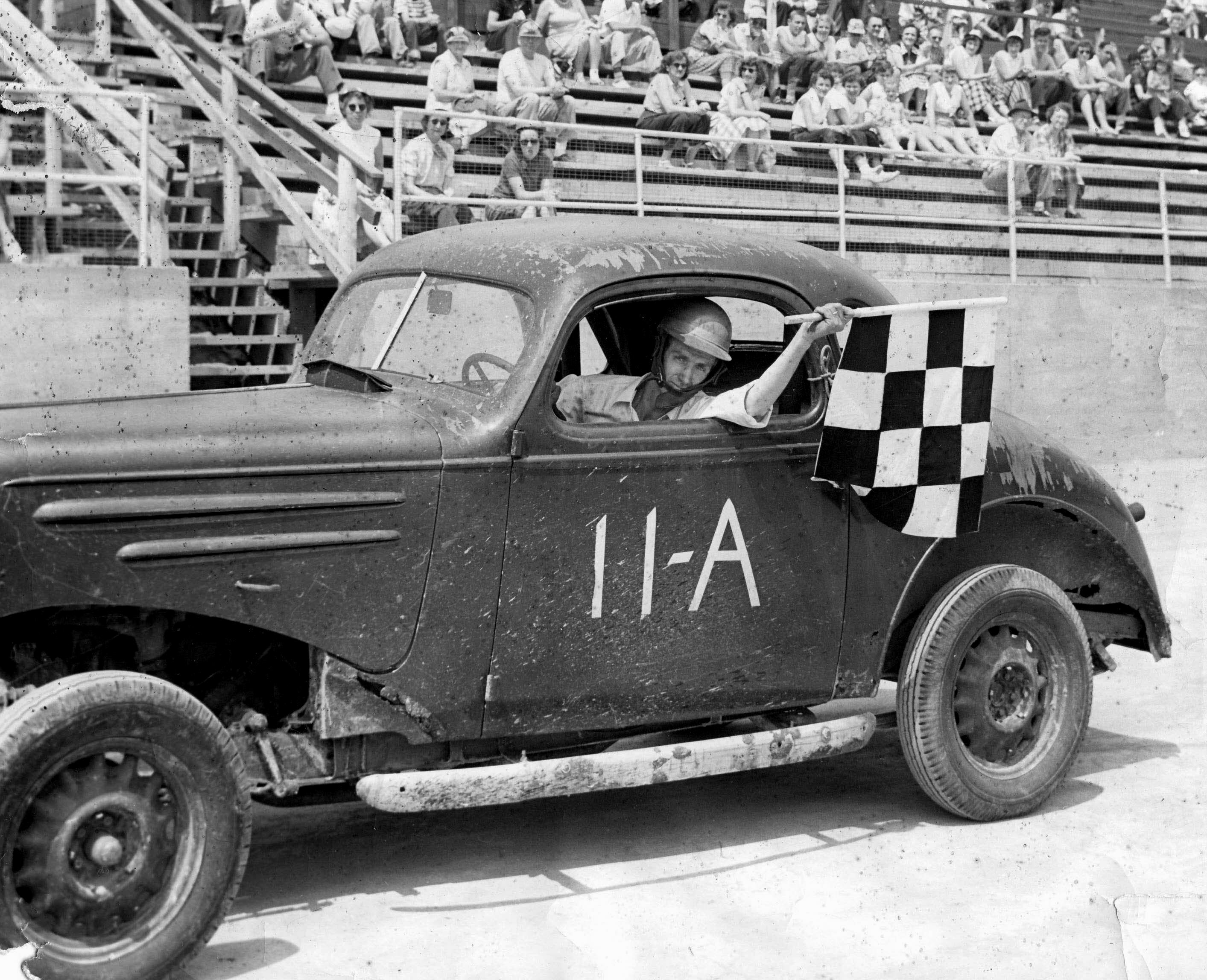
Courtesy of Provencher Family
There were perhaps as many photos taken at Pico in its opening program as there were the rest of the time combined. One of those photos is showing one of the two wrecks that occurred. However, the most interesting part of the shot shows the dozens of people standing on an adjoining railroad track, taking in a free program. I don't know how or if Pico dealt with that, but it certainly was not only a financial drain but also a safety issue – given the tendency of early stock cars to throw entire wheels.
Another photo, one taken by someone connected with Manchester, VT's star Dave Brooks, speaks volumes. A car #111 has pulled over to the scene of the crash that involved Johnny DeGraff and another car numbered X-10. The 111, likely driven by Big Bill Anderson, belonged to the Romano family, one of the track ownership. There was obvious concern not for the drivers and hnow their cars would be extricated; but, also, I'm sure Patsy Romano, Abe Newman, and Geno Franzoni were wondering what to do with the freeloaders in their vulnerable position.
Aldo Merusi Photo from Rutland Historical
Society
Driver Johnny DeGraff looks on as workers try to
determine how
they will extract his car and car X10. Check out the freeloaders
on the RR tracks just off the property. Below – The Romano brothers
111, the team backup car, stops at the wreck site.
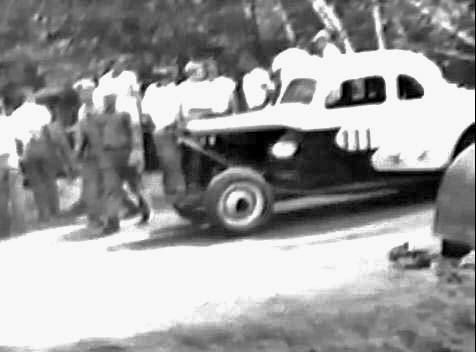
Courtesy of Bud Brooks
Another early shot of the same problem doesn't really show any free loaders, but it does illustrate how cars could reach someone hiding near the racing surface. Hugh Young, whose Fairmont Park Motor Speedway [also in Rutland County] was already contending with the aggressive and flashier Pico Raceway. He had run races at his venue [about 25 minutes from Pico] for two years before Pico began. Now he was in a real battle for cars and fans.
However, the single one factor that finally drive Hugh Young to close down the old former horse track in Fair Haven was the death of Marty Vinci, a local man who was hiding near the track, watching the races for free. I don't know how exactly the accident happened but Vinci, up in a tree, was likely struck by a car or perhaps a wheel off a car. The combination of declining fortunes and Vinci's death [which was not in any way Young's liability] was enough for Fairmont to fold its tents until May, 1962, when C.J. Richards re – opened it.
Bob Frazier Photo via Ed Fabian
This car, said to be Jud Cenette, has made it
into the trees off the racing surface at Fairmont. It certainly could have
struck a person, if there. Below – Fonda was a hit right away despite early
track surface problems. Here, the first winner,
Chuck Kotwicka, wins while most of the field struggles home, completely blinded
by mud on the
windshields, as shown by the guy behind him on the victory lap.

Ed Feuz Collection
Our third example comes from one of the most famous and iconic track anywhere in the Northeast. Fonda Speedway was formed in 1953, right after Pico Raceway had closed its doors. Many of the men who would become major stars at Fonda had run at Pico [and Fairmont before it]. Sporting a NASCAR sanction, the old fairgrounds track located dangerously close to the New York State Barge Canal, was a hit from Day One. Trouble was how close it was to NY Route 30A.
Right from the get go, cheapos figured out they could show up in Fonda, park somewhere close by, set up a step ladder, and watch the Fonda action – the cars coming right at them between turns one and two. This went on until 1955, when some of these spectators were struck by a wheel off the Burns & Wilson #100 driven by Jim Luke. 35 year – old Joseph Salek, a NY Thruway toll taker was killed and two women were injured. After that, the chain link fence along the sidewalk on Route 30A was adorned with heavy canvas tarps – all the way across.
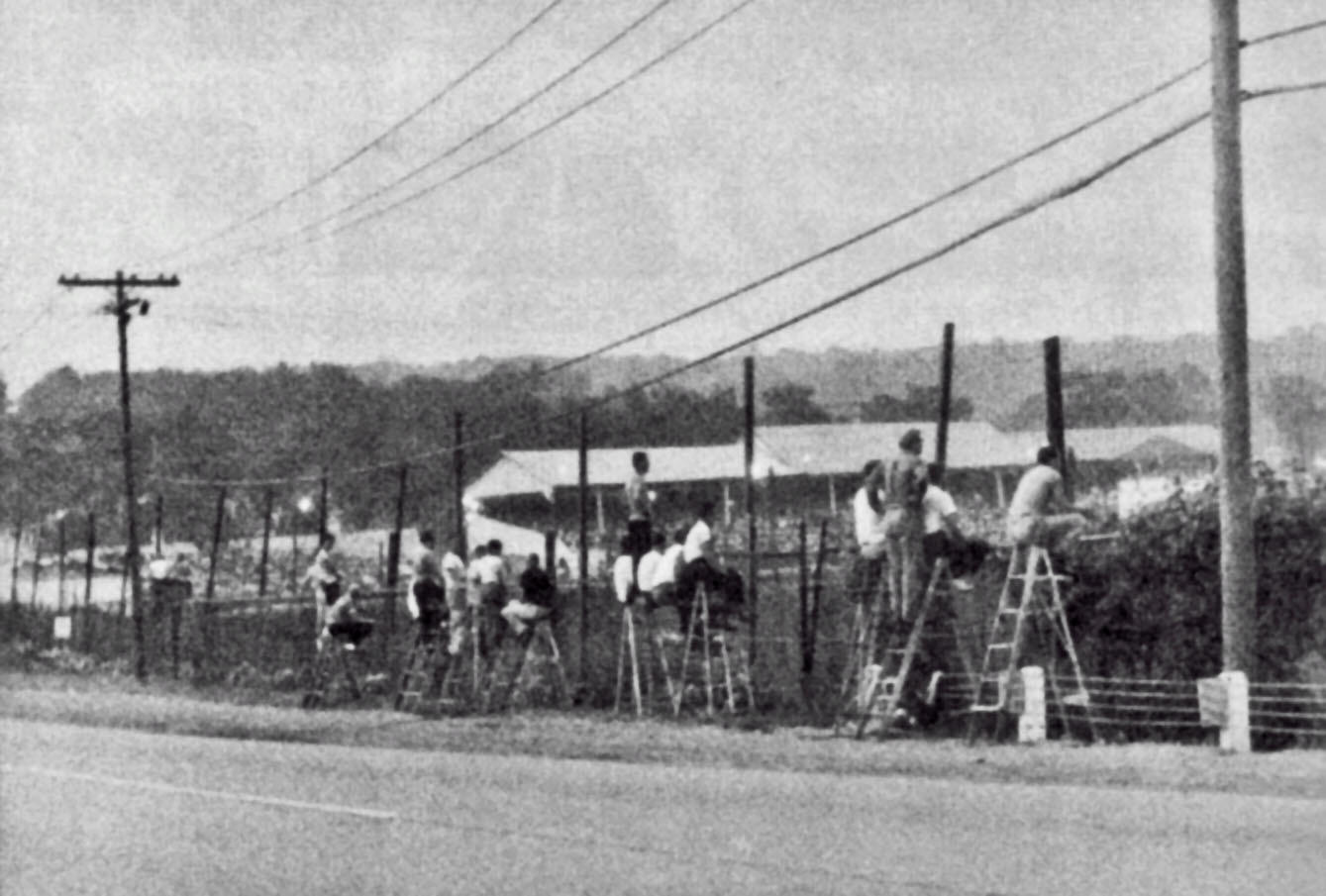
Courtesy of Lew Boyd
Freeloaders cozy up to the fence on stepladders
outside
Fonda Speedway prior to the Salek death in 1955. Below -
The track took measures after that to ensure no more
moochers were in harm's way.
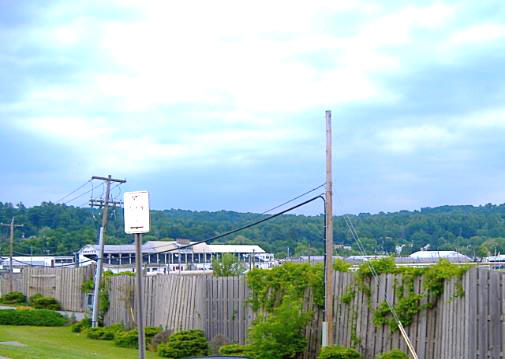
Courtesy of the Midstate Club
It is a good thing this was done, as speeds increased dramatically at Fonda after the overhead V-8 motor began to be used in the sportsman cars which ran there. The track, itself, having had effective updates from the old horse track infrastructure prior to 1953, kept errant cars in. But, flying wheels can never be predictably contained – except by tall catch fences like what Fonda has in front of the famous old covered grandstands.
Another place that occasionally wrestled with freeloaders was the Vermont State fairgrounds in Rutland, VT. People who didn't want to pay to see racing there would often crowd along the fence by turn 2, right beside Roxie's French Fries to catch a free peek. Trouble was – not only were the retaining fences not made for cars, but Roxie's propane tanks were only a few feet away from these people. They als used to pile up on the stairway on the back of Arts nad Crafts building, creating an obvious hazard due to the weight. C.J. Richards estimated his 1962 stock car program drew from ten to fifteen thousand people; but many didn't pay to actually go inside.
Bob Frazier Photo via CJ Richards
This photo of the start of C.J. Richards' record
– breaking stock
car show depicts the thousands in the stands and the also – huge
crowd beyond the fence and on the A&C building stairs. Below -
This shot shows Vic Love's 5, in the fence not far from Roxie's
propane tanks and all those turn one freeloaders. The tanks are just left
of the Fried Clams sign and the freeloaders can be seen to the right.
Courtesy of Norm Vadnais
About the same time was establishing Fonda as one of its important tracks in the Northeast, it was also setting up in the province of Quebec. In fact, a few of the teams which regularly appeared at the Montreal area NASCAR tracks would, once in a great while, show up at Fonda. Riverside Speedway, one of these tracks, was operated by the powerful Foley family – a group let's just say you didn't want to mess much with. Besides controlling most of the roads and bridges heading into Montreal, the organization had massive towing companies and at least that track.
Both Dick and Bob Foley, second generation in the family, also drove cars at these tracks. It seems that, for quite some time, some brave souls decided they would view the Foleys' races for free by climbing into trees that adjoined the track. The exasperated Foleys tried a number of things to discourage these guys, who apparently thought they could survive sleeping with the fishes wearing cement slippers.
The problem came to a head at one point around the end of the 1950's or beginning of the '60's when the Foleys had had enough. They brought in someone to douse the tree huggers with tear gas. This might have worked [and maybe even served the interlopers right] except for a prevailing breeze that sprang up off the Richelieu River next to the track. The tear gas may have even missed the tree toad, but it moved across the infield and attacked the paying spectators in the stands. I don't know how this turned out or whether it was acknowledged by track management, but it seemed to bring an end to the idiots in the trees.
Courtesy of Gary Nephew
You can see the trees lining the Riverside track
in this
photo, with one freeloader. Might have been before
the tear gas incident. Below – The shot of races in 1973, shows
what might be people in trees off turn four.
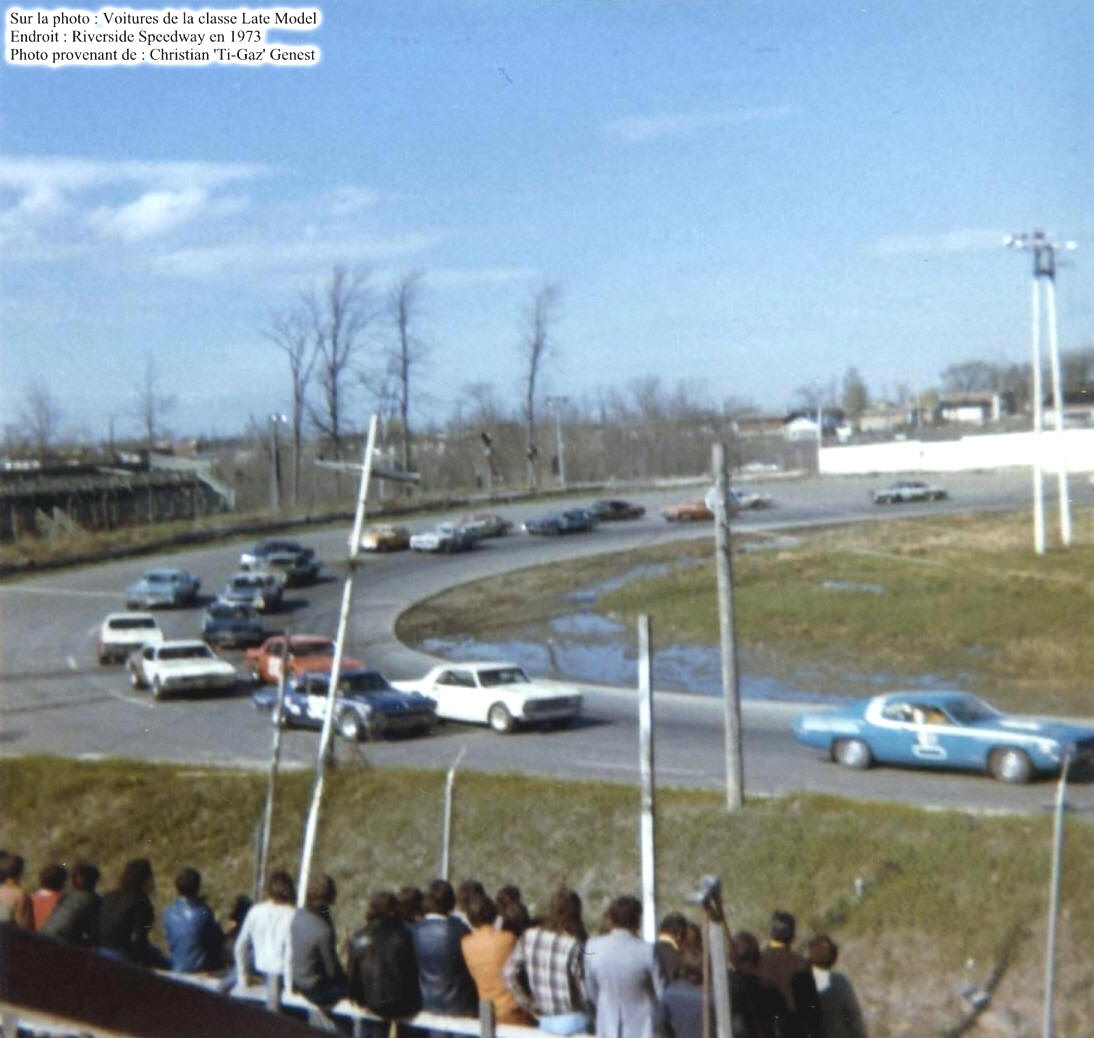
Courtesy of Christian Ti-Gaz Genest
Saranac Lake Speedway, started around 1959 and sharing some of the same racing teams as Riverside, was a very backwoods, rustic place that was carved out of the Aaron Hoyt farm – on Trudeau Road about ten minutes out of the town that gave the track its name. The bucolic half ,mile dirt track gave rise to such well – know drivers as Wes “Slugger” moody, a family friend of Hoyt and his son, Jimmy [who has the honor of experiencing arguably the worst wreck in Fonda history].
Saranac Lake would attract NASCAR teams from all over, including the Fonda area because it ran on Friday nights. Cars came in from the Montreal area, the Fonda/Victoria area, from Vermont, and – of course from the local area that included the Saturday night – running Airborne Park Speedway near Plattsburgh. Hoyt should have been doing well, even if it was a small operation; but he was losing his shirt.
Courtesy of Jackie Peterson
Jackie Peterson wins a race at Saranac Lake
Speedway in Shirley
Wallace's 1NY. Note the woods in the background. Below – This shot, taken around
2010 in the same spot,
shows how those same woods that sheltered freeloading onlookers, have reclaimed
the track.
Ladabouche Photo
Saranac Lake Speedway was really out in the sticks, and the Hoyts had no realistic way to secure the perimeters of the property. People would sneak in, throug the woods, to watch the racing from all over. Hoyt's limited staff could not possibly chase these people through the woods. The worst insult may have come from the family whose name inspired the road on which you drove to get to the track. Old Dr. Trudeau, a descendent of the famous Dr. Trudeau who had established the famous sanitarium in Saranac Lake, would drive a horse and buggy through the woods for a little free race watching. Hoyt finally threw in the towel in the mid 1960's – a real shame.
The final stories both center around the same race track. Catamount Stadium was built rather quickly early in 1965 and had a splashy opening despite the fact the early days of the track were marked with sparse fields of competitors. In its rather brief 18 year life, the track became one of the most important short tracks in he U.S.. A modified track at first, it would to the top of the racing world when management canned the coupes and sedans in favor or developing a late model sportsman agenda.
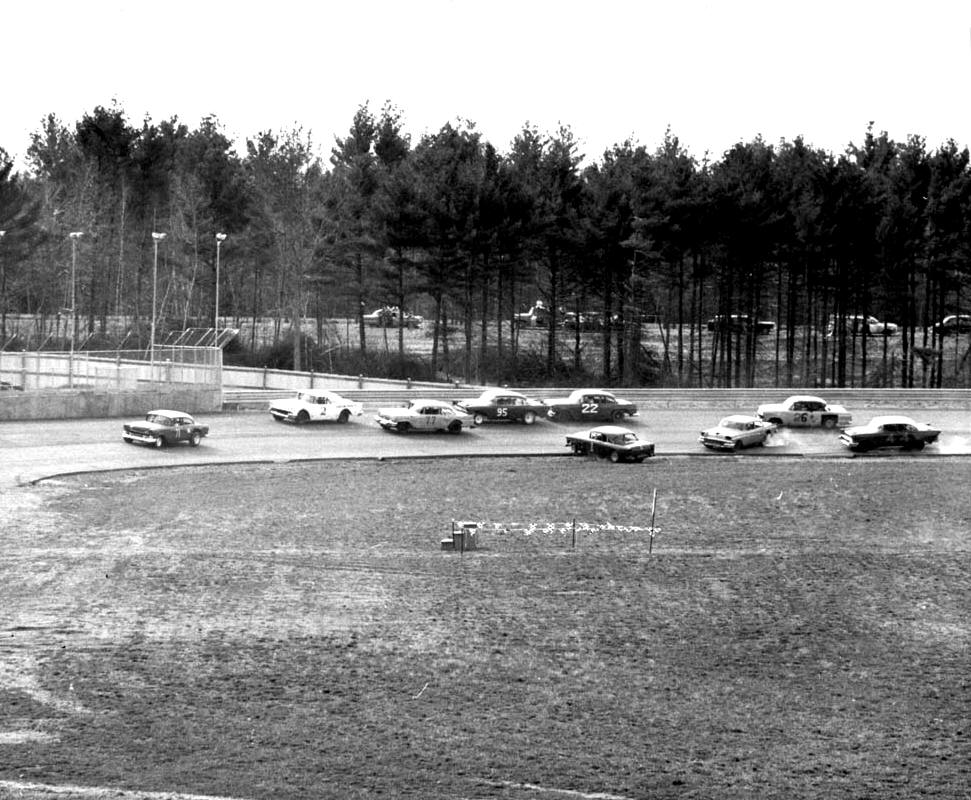
Courtesy of Cho Lee
This shot of early Flying Tigers at Catamount
shows cars parked off
Interstate 89. It also shows a rare glimpse of the first Bob Dragon
car in the lead. It only lasted a couple of races. Below – An early
tiger feature at Catamount
shows the infamoous Sibley boys'
treehouse [above the 2nd car] the outside of the metal fence.
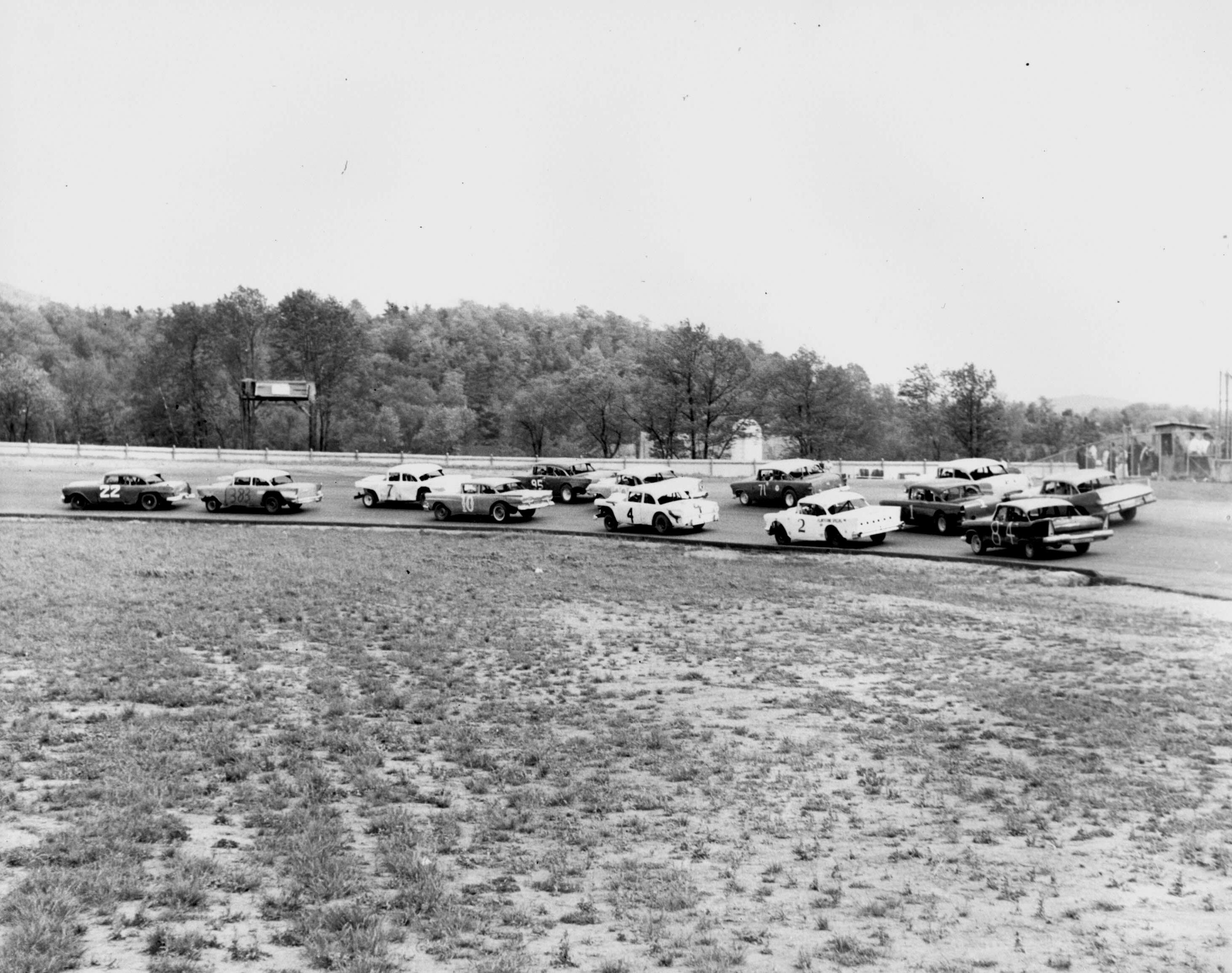
Courtesy of Cho Lee
In those early days, the track faced two problems with freeloaders. One, it was able to address and correct; one, it never did. As soon as Catamount began operations, neighboring land owners began towing in a tall hay wagon on which they and a number of friends could view the races over the familiar sheet metal fencing that surrounded all of the Catamount property except by the interstate. They did for many years, unabated. The height of that fence by the interstate [considering the elevated interstate bed] meant that, for a while, there would be people pulled off the northbound lane watching. That idn't last long thanks to police.
Catamount's other problem had to do with the infamous tree house of the neighboring Sibley brothers. Prominently looming – just off the property off the first turn, the tree house offered a perfect view of the racing for the boys, their sister, and friends. The company insuring Catamount that first season had an absolute fit. One sportsman driven by Marcel Godard had already nearly struck he tree, going flying off the banked turn. There was a real possibility of an errant wheel coming off and reaching the high platform was enough for the company to refuse to insure the track if they did not come up with a solution.
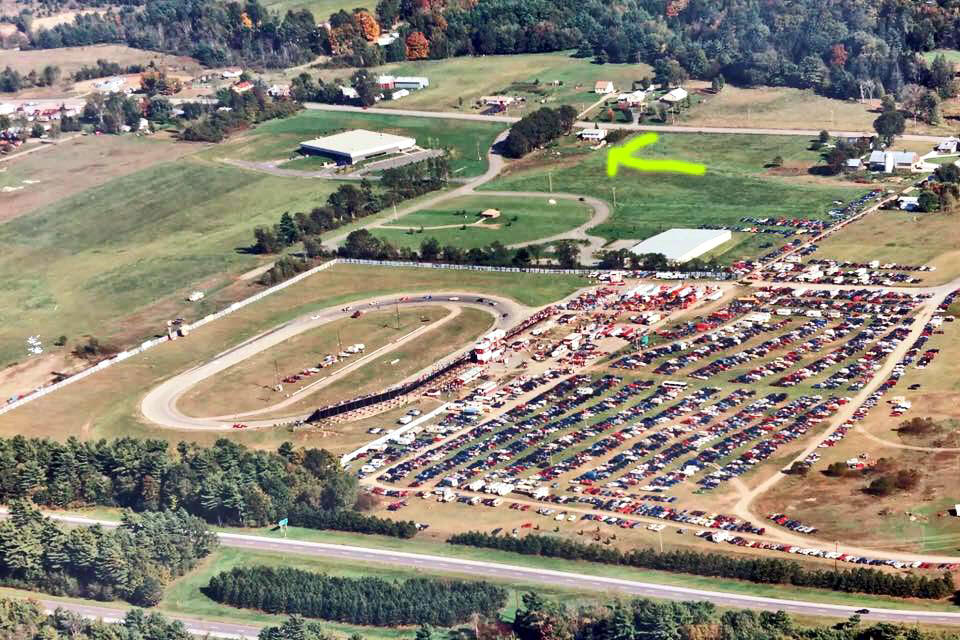
Mike Cain Photo via Leonard Parent
An aerial of the last real racing program
at Catamount shows how industrial development incursion
had wiped out the treehouse. The yellow arrow shows how far away the actual
Sibley house was
from the track. They must have sold property to GBIC before the track
closed.
Ken Squier approached the Sibley family and guaranteed the boys [the only siblings old enough to have a job] offers of good jobs at the track as long as they wanted them – as long as they stayed out of the tree house during race programs. In 2017 Ray Sibley delighted in telling stories of what he did for the track, eventually trucking around large sums of money after all the proceeds were counted.
Finally, the Nazareth half mile track had this one spot where freeloaders would manage to get above the metal fence and peer over at the action unfolding right below them – an annoying and dangerous situation for management. The track, according to some of the guys I talk with on Facebook, had quite a way of dealing with these pests. The water truck apparently not only had the usual water spreader, but it also had a hose that could be [and was] used to blast the idiots off their perches. It was necessary because at least one of these intruders had been killed watching the races from their illegal perch in the past and it had not deterred the rest.
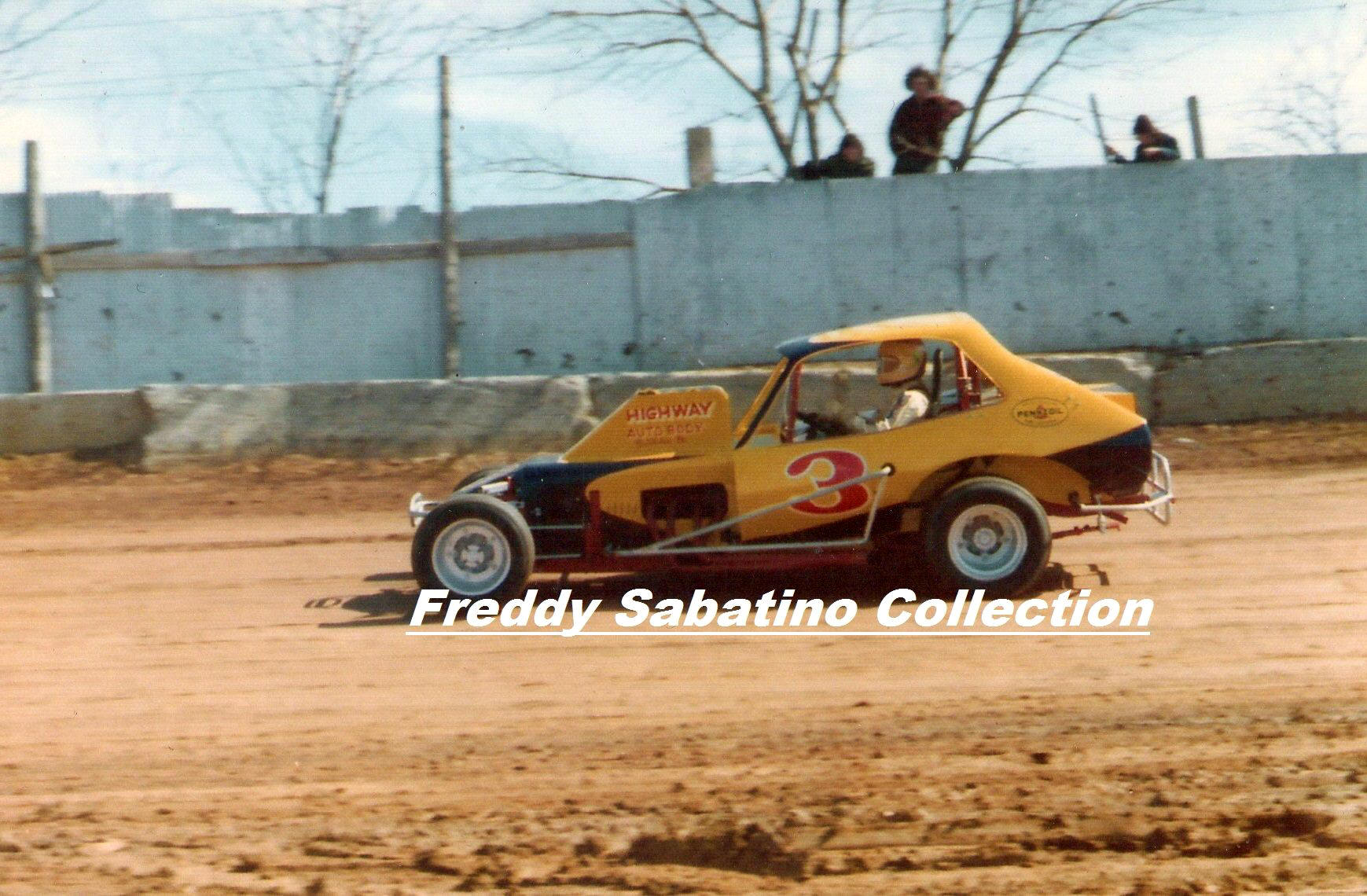
Courtesy of the Freddy Sabatino Collection
There they are, probably keeping a wary eye on
what the water
truck was doing.
There are dozens more stories just like these, but they are the ones I am familiar with. I am sure there are still efforts made today to see racing and other sports programs without paying. It just seems more colorful back in the day.
Please email me at wladabou@comcast.net if you have any photos to lend me or information and corrections I could benefit from. Please do not submit anything you are not willing to allow me to use on my website - and thanks. For those who still don’t like computers - my regular address is: Bill Ladabouche, 23 York Street, Swanton, Vermont 05488.
AS ALWAYS, DON’T FORGET TO CHECK OUT THE
REST OF MY WEBSITE:
www.catamountstadium.com
Return to the Main Page
Return to the Main News Page
Return to the All Links Page
Return to the Weekly Blog Links Page